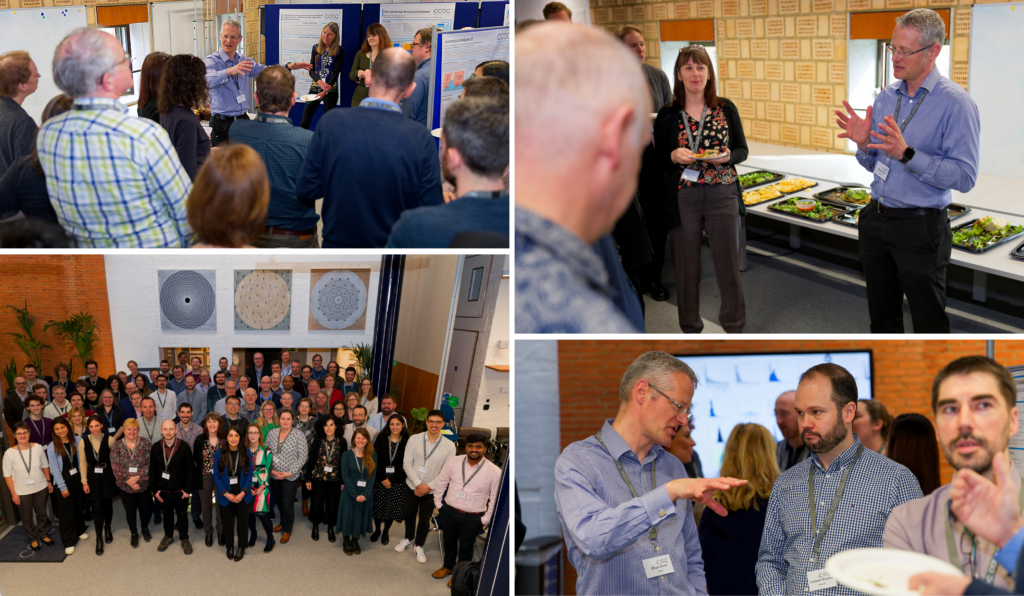Insights From the CEO – March 2024
Welcome to my new quarterly blog! Here I reflect on recent community events that brought together scientists from all backgrounds to shape the future of structural science.

The 15th CFC Celebratory Symposium
At the start of March, we hosted a symposium to celebrate the 15th year of the Crystal Form Consortium (CFC), a collaboration between development chemists from pharmaceutical companies and software, database, and research experts here at the CCDC.
The symposium brought together the members of the CFC, who discussed ways to keep advancing science with industry-focussed solid form structural informatics, and to support decision making for the design of new drugs.
Celebrating this global initiative to provide structural informatics tools and approaches for the rational design of the solid form, the CCDC and I thank the wonderful community of solid form scientists that gathered in Cambridge, UK to advance structural science.
It was wonderful to see over 100 people in our building, discussing, and sharing their best practises and methods. Engaging with the community of solid form experts is key for us as a crystallographic centre because it helps us to drive the science forward, which is part of our mission.
The 15th CFC symposium was a great occasion to discuss about challenges and opportunities for industries and the CCDC. I am grateful for this extraordinary community effort focused on the innovation of structural science.

To find out more about the CFC, watch on demand the webinar “The Crystal Form Consortium – Small Molecules BIG Challenges…an Industry Led Initiative To Help You Understand Your Active Ingredient” that took place on the 21st March 2024.
The Olga Kennard Symposium at the ACS in New Orleans
To honour Dr Olga Kennard, a pioneering figure in crystallography and founder of the Cambridge Structural Database (CSD) and the CCDC, the ACS Spring Meeting hosted a dedicated symposium that paid tribute to her remarkable contributions in science and beyond.
Dr Olga Kennard was a visionary leader who saw the potential for the collective use of data to accelerate the advancement of science. Her passion and vision played a crucial role in advancing structural chemistry and continues to inspire us all today.
Founded by Olga Kennard in 1965, the CCDC has a long history of innovation and excellence in the field of crystallography and now wider structural science. With that in mind, it was wonderful to celebrate Olga’s legacy at the ACS Spring meeting in New Orleans. I, as CCDC’s CEO, am impressed by the global community of people and friends who presented at the symposium and gathered to celebrate the profound impact that Olga had on science and on the society.
Looking to the future of the CCDC, we keep building on Olga’s legacy and remain committed to advancing her vision by continuing to provide a high-quality database of crystallographic data and by developing innovative tools, workflows, services, and knowledge-driven software suites to help scientists around the globe make new discoveries.

Find out more about the Virtual Special Issue of Crystal Growth & Design “Legacy and Future Impact of the Cambridge Structural Database: A Tribute to Dr. Olga Kennard”.
The InChI Trust and the WorldFAIR Effort
Our participation in the InChI Trust and the WorldFAIR effort demonstrate that one of our ongoing priorities is to keep working on setting and advancing international standards for data. We hosted a workshop run by the IUPAC WorldFAIR project to explore the challenges associated with sustainability of digital data standards for chemistry. We also hosted a meeting of the InChI Trust Board that included an update open to the public on recent InChI developments.
Our FAIR journey (the effort to make data Findable, Accessible, Interoperable and Reusable) continues to set the best international standards for data handling and we continue to invest strategically to advance crystal structure prediction and other scientific methods.
With the growing importance of computational and theoretical chemistry, and the ability to make predictions based on data and algorithms, we are working on the concept of “digital first”. This concept is growing in popularity as it guides experimental work and saves a lot of costs, reflecting digital transformation trends that many organisations are innovating with to advance their business models and operations.
Focusing on the concept of “digital first”, the use of the IUPAC International Chemical Identifier (InChI) provides a standard way to encode molecular information and facilitates the search for such information in databases and on the web.
For cheminformaticians, embedding support for the InChI in our database, software and workflows enables reliable lookup of structures and interoperability between CCDC and external systems. With InChIs, we are moving towards a more connected structural science universe that brings all the key data sources closer together, enabling researchers to readily benefit from synergies across a diverse range of scientific resources.
By hosting this event on the WorldFAIR and InChIs here at the CCDC, we helped to set and advance the international data standards. I couldn’t be more thankful for all the hard work that all our community is doing to support this effort.

To find out more about FAIR data, read the blog “Boosting Research Efficiency in Industry with FAIR Data”.
To discover more about the interoperability initiatives to embed InChIs in the CSD, read the blog “InChIs, Stereochemistry, and ChemDraw Export – New Interoperability Initiatives”.
Next Steps
To discuss further and/or request a demo with one of our scientists, please contact us via this form or .